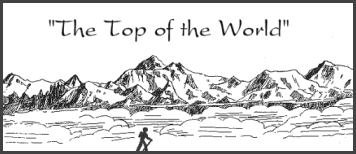
This lucky trekker could be you!
"TREKKING IN THE NEPAL HIMALAYA"
This lucky trekker could be you! |
| Contents - from Kathmandu University ("Nepal Showcase") |

|
Medical Matters & Advice |
| Trekking in Nepal need not be considered a risky affair as far as your health is concerned. Nevertheless, preventive measures such as a thorough medical check up and inoculations before you start trekking can save you from unexpected hazards. Since the remote places of Nepal are not supplied with necessities that are essential for modern medical treatment, and the rescue and evacuation procedures are usually measured in days, it is imperative to make a comprehensive First Aid Kit consisting of basic drugs and accessories as part of your gear for trekking. Various trekking guide books and the pamphlet published by the Himalayan Rescue Association give you detailed information and a complete list of medical supplies. These guide books are easily available in the book shops of Kathmandu. In case of serious illness or injury, prompt evacuation to Kathmandu (or Bangkok, Thailand if possible) is the best remedy. Modern dentistry is unknown in the hills of Nepal, so it is advised to have a checkup before departure from home. Tooth fillings sometimes loosen in cold temperatures and at high altitudes, so it is recommended to have them checked. |
Fitness
All trekking demands a level of physical capability to put in a good day's walking, uphill and down. Most trekkers should avoid gaining more than 500 meters in altitude in one day above 3000 meters. There should be plenty of time during the day to cover this distance, so the physical exertion, though quite strenuous at times, is not sustained. The best preparation for trekking is cycling, swimming, jogging, squash, tennis, and long walks involving going up and down hills. Good physical conditioning will help for the maximum enjoyment of the trek.
Altitude Sickness
Altitude sickness, often known as Acute Mountain Sickness (AMS), is a particularly important medical consideration while trekking in Nepal. Altitude sickness means the effect of altitude on those who ascend too rapidly to elevations above 3000 meters. The initial symptoms of AMS are as follows:These symptoms are to be taken very seriously. In case of the appearance of any of the above symptoms, any further ascent should be reconsidered; otherwise more serious problems can occur which can cause death, sometimes within a few hours. The only cure for the Altitude Sickness is to descend to lower elevations immediately. Acclimatization by ascending to no more than 300 to 500 meters per day above 3000 meters and the proper amount of rest are the best methods for prevention of AMS.
- Nausea, vomiting
- Loss of appetite
- Insomnia/ sleeplessness
- Persistent headaches
- Dizziness, light headaches, confusion
- Disorientation, drunken gait
- Weakness, fatigue, lassitude, heavy legs
- Slight swelling of hands and face
- Breathlessness and Breathing irregularly
- Reduced urine output
Literature and pamphlets published by Himalayan Rescue Association contains detailed information on AMS. The Central Immigration Office and all trekking agencies in Kathmandu distribute this pamphlet free of cost. Since these documents also give information on the list of suggested medical supplies for trekkers it is a compulsory item for every trekkers' medical KIT.
Medical, Rescue, Transport, and Communication Facilities on some major trekking routes:
Everest and Kanchanjunga Treks
A small hospital and an airstrip at Jiri , Phaplu and Khunde (Syangboche). Similarly a medical facility operated by HRA is situated at Pheriche. There are also radio stations at Chainpur, Khandari, Taplejung, Phiddim, Bhojpur, Terathum, Dhankuta , Dharan , Illam , Chandra-gadhi, Jiri, Namche Bazaar, Thayangbhoche, Pheriche, Lobuche and Salleri.
Helambu, Gosainkuda and Langtang
Modern medical facilities are not available in the Helambu area. For Gosainkunda and Langtang, there is a government hospital at Trishuli Bazaar and a dispensary at Dhunche. There is also a radio and television link to Kathmandu at Trishuli Bazaar. An airstrip is located near Kyangjin in Langtang Valley. The other two radio stations are on the Bhotekoshi at Rasuwa Gadhi on the Tibetan Border and in Dhunche.
Around Pokhara, Lamjung, Jomsom, Muktinath and Manang Pokhara has an all-weather airport, good telecommunication network and a modern hospital . District hospitals are located in Baglung, Beshishahar and Jomsom. There is a Trekkers' Aid Post run by the Himalayan Rescue Association in Manang. Additionally there is a small government dispensary at Hongde and Chame. The headquarters of the Manang District, also serve both foreigners and locals. Airstrips are located at Jomsom, Hongde and Belawa of Baglung. There are radio stations at Chame, Kusuma, Baglung, Beni, and Jomsom.
There are radio stations at Gorkha and Besisahar. A government hospital is located in Gorkha. The United Mission to Nepal runs a hospital at Ampipal of Gorkha.
Jumla and Rara
Airstrips are located in Dhorpatan, Jumla and Simikot. There is a government hospital and a radio station in Jumla. A dispensary is run at Gumgadhi.

|
Home |
Rafting |
Mountain Flight |
Jungle safari |
About Us
© 1996 - 2020 Go2Nepal.com. All Rights Reserved. Modified: 2020/03/14 15:20:00 - Webmaster: Jack B. Shatzer |